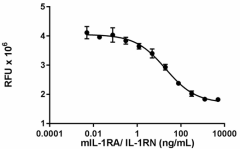- Regulatory Status
- RUO
- Other Names
- Interleukin-1 receptor antagonist protein, IL-1RA, IL-1F3, ICIL-1RA, IRAP, IL-1RN, DIRA, IL-1 inhibitor

-

Recombinant mouse IL-1RA (IL-1RN) inhibits the proliferation of D10.G4.1 cells induced by recombinant human IL-1α at 50 pg/mL (Cat. No. 570002). The ED50 for this effect is 10 - 50 ng/mL. -

Stability Testing for Recombinant Mouse IL-1RA (IL-1RN). Recombinant Mouse IL-1RA/IL-1RN was aliquoted in PBS, pH7.2 at 0.2 mg/mL. One aliquot was frozen and thawed four times (4x Freeze/Thaws) and compared to the control that was kept at 4°C (control). The samples were tested for their ability to inhibit the proliferation of D10.G4.1 cells induced by recombinant human IL-1α at 50 pg/mL (Cat. No. 570002). The ED50 for this effect is 10 - 50 ng/mL.
| Cat # | Size | Price | Quantity Check Availability | ||
|---|---|---|---|---|---|
| 769702 | 10 µg | $159.00 | |||
| 769704 | 25 µg | $323.00 | |||
| 769706 | 100 µg | $879.00 | |||
| 769708 | 500 µg | $2343.00 | |||
IL-1 receptor antagonist, IL-1RA/IL-1RN, was initially purified from media conditioned by human monocytes. IL-1RA belongs to the IL-1 family of cytokines, which includes 11 members in three subfamilies including IL-1RA: the IL-1 subfamily (IL-1α, IL-1β, IL-33), the IL-18 subfamily (IL-18 and IL-37), and the IL-36 subfamily (IL-36Rα, IL-36α, β, γ, and IL-38). Although all members are secreted proteins, IL-1RA is the only one that possesses a signal peptide, and it is secreted via the endoplasmic reticulum and Golgi apparatus. In addition to the glycosylated secreted IL-1RA, an intracellular unglycosylated isoform has been described. The two forms of IL-1RA are encoded by a single gene, generated by alternative usage of the first two exons, and their expression is regulated by two promoters. IL-1RA binds tightly to IL-1RI, blocks the binding of IL-1α and IL-1β to the receptor, inhibits the recruitment of IL-1RAP (a receptor accessory protein), and thus the signal transduction induced by IL-1α and IL-1β. IL-1RA also binds to the non-signaling/decoy receptor IL-1RII. IL-1RA exhibits potent anti-inflammatory properties in vivo and can mediate protective effects against inflammatory diseases. IL-1RA has been used in controlled clinical trials for the treatment of rheumatoid arthritis (RA). It has been reported that it reduces clinical signs and symptoms associated with the disease. IL-1RA (Kineret®, Anakinra) has also been used in the treatment of type 2 diabetes and RA.
Product Details
- Source
- Mouse IL-1Rα amino acids Met-(Arg8-Gln159) (Accession #Q542W1) was expressed in E.coli.
- Molecular Mass
- The 153 amino acid recombinant protein has a predicted molecular mass of approximately 17.4kD. The DTT-reduced and non-reduced protein migrate at approximately 18 kD by SDS-PAGE. The predicted N-terminal amino acid is Met.
- Purity
- >95%, as determined by Coomassie stained SDS-PAGE.
- Formulation
- 0.22 μm filtered protein solution is in PBS pH7.2, 10mm DTT.
- Endotoxin Level
- Less than 0.1 EU per µg cytokine as determined by the LAL method.
- Concentration
- 10 and 25 µg sizes are bottled at 200 µg/mL. 100 µg size and larger sizes are lot-specific and bottled at the concentration indicated on the vial. To obtain lot-specific concentration and expiration, please enter the lot number in our Certificate of Analysis online tool.
- Storage & Handling
- Unopened vial can be stored between 2°C and 8°C for up to 2 weeks, at -20°C for up to six months, or at -70°C or colder until the expiration date. For maximum results, quick spin vial prior to opening. The protein can be aliquoted and stored at -20°C or colder. Stock solutions can also be prepared at 50 - 100 µg/mL in appropriate sterile buffer, carrier protein such as 0.2 - 1% BSA or HSA can be added when preparing the stock solution. Aliquots can be stored between 2°C and 8°C for up to one week and stored at -20°C or colder for up to 3 months. Avoid repeated freeze/thaw cycles.
- Activity
- Recombinant mouse IL-1RA (IL-1RN) inhibits the proliferation of D10.G4.1 cells induced by recombinant human IL-1α at 50 pg/mL (Cat. No. 570002). The ED50 for this effect is 10 - 50 ng/mL.
- Application
-
Bioassay
- Application Notes
-
BioLegend carrier-free recombinant proteins provided in liquid format are shipped on blue ice. Our comparison testing data indicates that when handled and stored as recommended, the liquid format has equal or better stability and shelf-life compared to commercially available lyophilized proteins after reconstitution. Our liquid proteins are verified in-house to maintain activity after shipping on blue ice and are backed by our 100% satisfaction guarantee. If you have any concerns, contact us at tech@biolegend.com.
Antigen Details
- Structure
- Monomer
- Distribution
-
Monocytes, neutrophils, macrophages, endothelial cells, corneal epithelial cells, oral mucosa epithelial cells, fibroblasts, mesenchymal stem cells
- Function
- Inhibits the activity of IL-1β and IL-1α by binding to the receptor IL-1RI and blocking the downstream signaling. IL-1RA is induced by IL-1, LPS, IgG complexes, IL-4, and IL-10.
- Interaction
- T cells, fibroblasts, endothelial cells, epithelial cells, monocytes, dendritic cells, cardiomyocytes
- Ligand/Receptor
- Type I and II IL-1 receptors (IL-1RI and IL-1RII).
- Bioactivity
- Recombinant mouse IL-1RA inhibits the proliferation of D10.G4.1 cells.
- Cell Type
- Endothelial cells, Epithelial cells, Fibroblasts, Leukocytes, Lymphocytes, Macrophages, Mesenchymal Stem Cells, Monocytes, Neutrophils
- Biology Area
- Adaptive Immunity, Immunology
- Molecular Family
- Cytokines/Chemokines
- Antigen References
-
- Hannum CH, et al. 1990. Nature 343:336.
- Cohen S, et al. 2002. Arthritis Rheum. 46:614.
- Arend WP, et al. 2002. Cytokine Growth Factor Rev. 13:323.
- Botsios C, et al. 2007. Reumatismo 59:32.
- Larsen C, et al. 2007. N Engl J Med. 356:1517.
- Dinarello CA. 2018 Immunol Rev. 281:8.
- Gene ID
- 16181 View all products for this Gene ID
- UniProt
- View information about IL-1RA on UniProt.org
